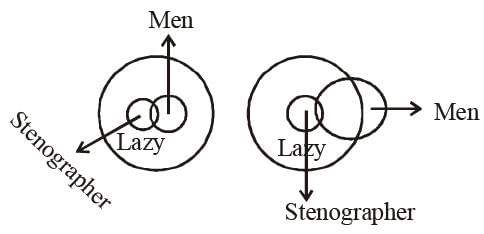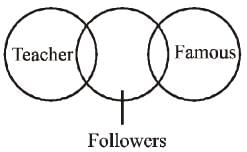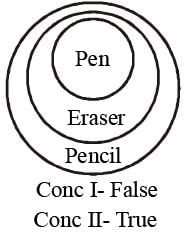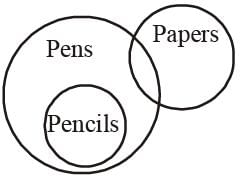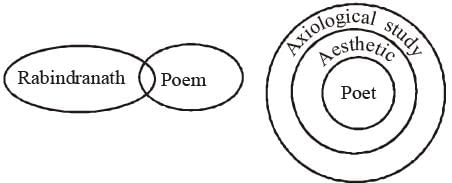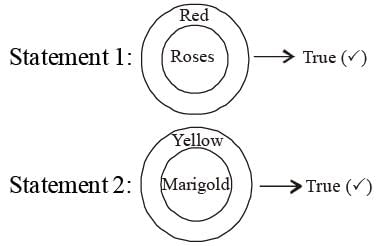SSC CGL Previous Year Questions: Statement & Arguments and Statement & Conclusions - 2 - SSC CGL MCQ
30 Questions MCQ Test - SSC CGL Previous Year Questions: Statement & Arguments and Statement & Conclusions - 2
Consider the given statement/s to be true and decide which of the given conclusions/assumptions can definitely be drawn from the given statement. (SSC CGL 1st Sit. 2016)
Statements:
1. All stenographers are lazy.
2. Some men are stenographers.
Conclusions:
I. All lazy people are men.
II. Some men are lazy.
1. All stenographers are lazy.
2. Some men are stenographers.
I. All lazy people are men.
II. Some men are lazy.
Consider the given statement/s to be true and decide which of the given conclusions/assumptions can definitely be drawn from the given statement. (SSC CGL 1st Sit. 2016)
Statements:
1. Some teacher are followers.
2. Some followers are famous.
Conclusions:
I. Some teachers are famous.
II. Some followers are teachers.
1. Some teacher are followers.
2. Some followers are famous.
I. Some teachers are famous.
II. Some followers are teachers.
Three statements are given followed by three conclusions I, II and III. You have to consider the three statements to be true even if they seem to be at variance from commonly known facts. You have to decide which of the given conclusions, if any, follow from the given statements. (SSC Steno. 2016)
Statements:
1. Mary said, "Ann and I both have cats,"
2. Ann said, "I don't have a cat."
3. Marry always tells the truth, but Ann sometimes lies.
Conclusion:
I. Ann has a cat.
II. Mary has a cat.
III. Ann is lying.
1. Mary said, "Ann and I both have cats,"
2. Ann said, "I don't have a cat."
3. Marry always tells the truth, but Ann sometimes lies.
I. Ann has a cat.
II. Mary has a cat.
III. Ann is lying.
What do you infer from the following set of statements ?
I have observed many plant roots.
All these plant roots were found to grow downward. (SSC Steno. 2016)
A 7 metre long piece of cloth is cut into three smaller pieces.How long is the longest of the three pieces? (SSC Sub. Ins. 2016)
Given that Statements:
I. One piece is 3.70 metre long.
II. One piece is 1.50 metre longer than another piece and the remaining piece is 90 cm long.
Two statements are given, followed by two conclusions I and II. You have to consider the statements to be true even if they seems to be at variance from commonly known facts. You have to decide which of the given conclusions, if any, follow from the given statements. (SSC Sub. Ins. 2016)
Statements:
1. All Pens are Erasers.
2. All Erasers are Pencils.
Conclusion:
I. All Pencils are Pens.
II. All Pens are Pencils.
DIRECTIONS: In the following Questions, one statement is given followed by two conclusions, I and II.
You have to consider the statement to be true, even if it seems to be at variance from commonly known facts. You are to decide which of the given conclusions can definitely be drawn from the given statement. Indicate your answer. (SSC CGL 1st Sit. 2015)
Statement : Every school should promote partnerships that will increase parental involvement and participation for promoting the growth of children.
Conclusions I: For the growth of the children, parents should be involved in various school activities.
Conclusions II: Involvement of parents in school activities has no influence on the growth of the children.
DIRECTIONS: In the following Questions, one statement is given followed by two conclusions, I and II.
You have to consider the statement to be true, even if it seems to be at variance from commonly known facts. You are to decide which of the given conclusions can definitely be drawn from the given statement. Indicate your answer. (SSC CGL 1st Sit. 2015)
Statement : Aggressive animals can be train ed with care and affection to behave as the occassion demands.
Conclusions I : Trained dogs cannot be aggressive.
Conclusions II : Animals are always aggressive unless care and affection is given to them.
DIRECTIONS: Questions, one or statements is given followed by two conclusions/assumptions, I and II. You have to consider the statement to be true, even if it seems to be at variance from commonly known facts. You have to decide which of the given conclusions/assumptions can definitely be drawn from the given statement. (SSC CGL 1st Sit. 2015)
Statement: No rod is pod, No pod is flexible.
Inferences:
I. No rod is flexible.
II. Some pods are flexible
DIRECTIONS: Questions, one or two statements is given followed by two conclusions/assumptions, I and II. You have to consider the statement to be true, even if it seems to be at variance from commonly known facts. You have to decide which of the given conclusions/assumptions can definitely be drawn from the given statement. (SSC CGL 1st Sit. 2015)
Statement: A good book even if costly is sold out in no time.
Assumptions:
I. Some books are better than others
II. All good books are costly
DIRECTIONS: In question below one or two statements are given followed by two conclusions I and II. You have to consider the statement to be true, even if it seems to be at variance from commonly known facts. You are to decide which of the given conclusions can definitely be drawn from the given statement. Indicate your answer. (SSC Sub. Ins. 2015)
Statements:
(a) Some schools are Labor atories
(b) All Laboratories are theaters
Conclusions:
I. Some theatres are schools
II. No school is a theater
DIRECTIONS: In question below one or two statements are given followed by two conclusions I and II. You have to consider the statement to be true, even if it seems to be at variance from commonly known facts. You are to decide which of the given conclusions can definitely be drawn from the given statement. Indicate your answer. (SSC Sub. Ins. 2015)
Statement:
Cactus plants are fleshy but need less water
Conclusions:
I. All fleshy plants are cactus
II. Cactus plants need less water
Two statements are given, each followed by two conclusion/ assumption, I and II. You have to consider the statement to be true even if they seem to be at variance from commonly known facts. You have to decide which of the given conclusion/assumptions, if any, follows from the given statements. (SSC CHSL 2015)
Statements:
(i) Some papers are pens.
(ii) All the pencils are pens.
Conclusion:
I. Some pens are pencils
II. Some pens are papers
Which conclusion is true with respect to the given statements? (SSC CHSL 2015)
Statements:
(i) Roy studies History and Political Science
(ii) Roy studies in Oxford University.
Conclusion:
DIRECTIONS: One/ two statement are given, each followed by two conclusion/assumption, I and II. You have to consider the statement to be true even if they seem to be at variance from commonly known facts. You have to decide which of the given conclusion/ assumptions, if any, follows from the given statements (SSC CHSL 2015)
Statement: Continuous training is essential for all employees to increase their productivity
Assumptions:
I. Training is an essential component for productivity.
II. Profitability & productivity are supplementary to each other.
DIRECTIONS: One/ two statement are given, each followed by two conclusion/assumption, I and II. You have to consider the statement to be true even if they seem to be at variance from commonly known facts. You have to decide which of the given conclusion/ assumptions, if any, follows from the given statements (SSC CHSL 2015)
Statement: Travelling by metro in Delhi is more convenient and economical.
Assumptions:
I. Other modes of tr ansport are not available.
II. Metro services are reasonably good.
DIRECTIONS: In the questions, Three statements are given followed by two/four conclusions I, II, III, & IV. You have to consider the three statements to be true even if they seem to be at variance from commonly known facts. You have to decide which of the given conclusions if any follow from the given statements. (SSC CHSL 2014)
Statements:
1. Rabin dranath Tagore wrote many poems.
2. Every poet has aesthetic knowledge.
3. Aesthetic is a part of axiological study.
Conclusions:
I. Rabindran ath Tagore did different axiological study.
II. He followed the base of logic and ethics.
DIRECTIONS: In the questions, Three statements are given followed by two/four conclusions I, II, III, & IV. You have to consider the three statements to be true even if they seem to be at variance from commonly known facts. You have to decide which of the given conclusions if any follow from the given statements. (SSC CHSL 2014)
Statements:
1. All clerks are superin tenden ts.
2. All super intendents are managers.
3. All managers ar e supervisors.
Conclusions:
I. All supervisors are clerks.
II. Some clerks are supervisors.
III. All superintendents are clerks.
DIRECTIONS: In the question, Three statements are given followed by two/four conclusions I, II, III, & IV. You have to consider the three statements to be true even if they seem to be at variance from commonly known facts. You have to decide which of the given conclusions if any follow from the given statements. (SSC Steno. 2014)
Statements:
I. Meen a is older than Roma.
II. Rashmi is older than Meena.
III. Roma is older then Rashmi.
If 1st two statements are true then 3rd statement is
DIRECTIONS: In the questions, Three statements are given followed by two/four conclusions I, II, III, & IV. You have to consider the three statements to be true even if they seem to be at variance from commonly known facts. You have to decide which of the given conclusions if any follow from the given statements. (SSC Steno. 2014)
Statements:
All athletes are brave.
All girls are athletes.
Conclusions:
I. All girls are brave.
II. Some athletes are girls.
When you don't know how to proceed with an urgent official work, you will. (SSC Steno. 2014)
When I witness an accident, I (SSC Steno. 2014)
While speaking to an audience, you feel that (SSC Steno. 2014)
Either he is intelligent or industries (SSC Steno. 2014)
While having an argument with someone, if you fail (SSC Steno. 2014)
One statement is given followed by two Conclusions I and II. You have to consider the statement to be true, even if it seems to be at variance from commonly known facts. You are to decide which of the given conclusions can definitely be drawn from the given statement. Indicate your answer. (SSC CGL 2014)
Statement:
The rich must live more simply.
All poor people are simple.
Conclusions:
I. Rich people waste money.
II. Poor people save money.
(1) All roses in Sita's garden are red. (SSC CGL 2014)
(2) All marigold flowers in Sita's garden are orange.
(3) All flowers in Sita's garden are either red or orange.
If 1st two statements are true, the third is
Two statements are given followed by two conclusions I and II. You have to consider the statements to be true, even if they seem to be at variance from commonly known facts. You are to decide which of the given conclusions definitely follows from the given statements. Indicate your answer. (SSC Multitasking 2014)
Statements:
All pencils are rails.
All rails are stations.
Conclusions:
I. All stations are pencils.
II. Some stations are pencils.
DIRECTIONS: In question below, some statements are given followed by three/two conclusions/assumptions respectively. You have to consider the statements to be true even if they seem to be at variance from commonly known facts.
You have to decide which of the given conclusions/assumptions if any, follow from the given statements. (SSC Sub. Ins. 2014)
Statement:
Pictures can tell a story. All story books have pictures.
Some story books have words.
Conclusions:
I. Pictures can tell a story better than words can.
II. The stories in story books are very simple.
III. Some story books have both words and pictures.
DIRECTIONS: In question below, some statements are given followed by three/two conclusions/assumptions respectively. You have to consider the statements to be true even if they seem to be at variance from commonly known facts.
You have to decide which of the given conclusions/assumptions if any, follow from the given statements. (SSC Sub. Ins. 2014)
Statement:
It is desirable to put the child in school at the age of 5 or so.
Assumptions:
I. At that age the child reaches appropriate level of development and is ready to learn.
II. The schools do not admit ch ildren after 6 years of age.


